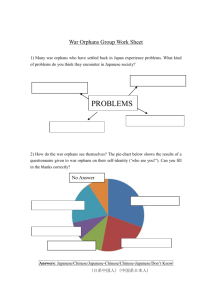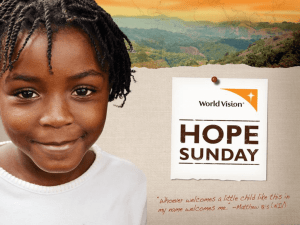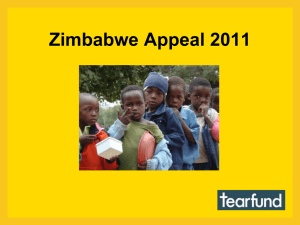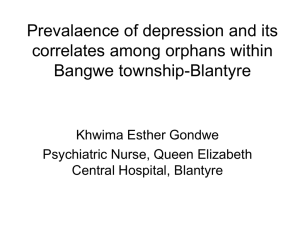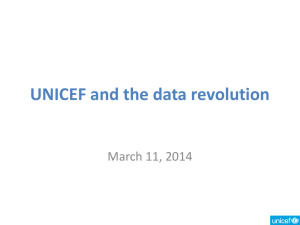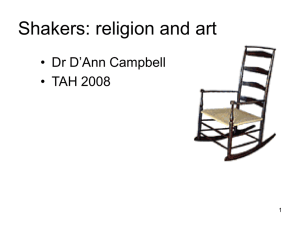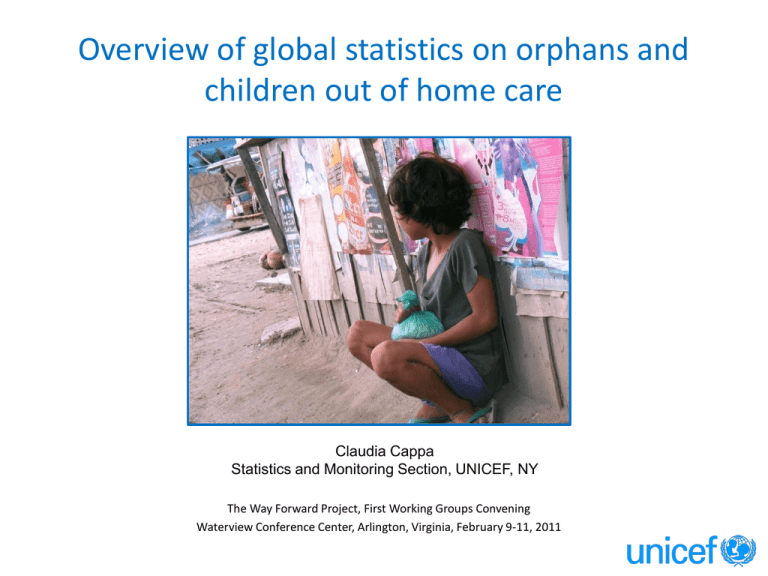
Overview of global statistics on orphans and
children out of home care
Claudia Cappa
Statistics and Monitoring Section, UNICEF, NY
The Way Forward Project, First Working Groups Convening
Waterview Conference Center, Arlington, Virginia, February 9-11, 2011
Outline
• Present global estimates of orphans and explain how
these numbers are calculated
• Examples of data analysis on orphans and main
findings
• UNICEF support for data collection on orphans and
children’s living arrangements
• UNICEF methodological work on estimates of
children out of home care
• Interagency work on children in formal care
Global estimates on orphans
Definition of orphans
• A child who has lost one or both parents (i.e. not only children who have
lost both parents, but also those who have lost a father but have a
surviving mother or have lost their mother but have a surviving father)
• Definition adopted in the mid-1990s as the AIDS pandemic began leading
to the death of millions of parents worldwide
• Terminology of a ‘single orphan’ – the loss of one parent – and a ‘double
orphan’ – the loss of both parents
• Estimates not be interpreted to mean that these children are in need of a
new family, shelter, or care
• Evidence clearly shows that the vast majority of orphans are living with a
surviving parent, grandparent, or other family member. More than 90 per
cent of all orphans are over the age of five
Interagency estimates on orphans
Methods
• Nationally representative surveys
• Demographic calculations
National surveys
• Two main sources
– Demographic and Health Surveys (DHS)
– Multiple Independent Cluster Surveys (MICS)
• Strengths
– Nationally representative samples of households
– Provides detail on age, orphanhood status and wellbeing of children
• Weaknesses
– Only captures children living in households
– May under-estimate maternal orphans
Demographic estimates
• Prepared by United Nations Agencies
• Based on demographic estimates and
projection for all countries prepared by United
Nations Population Division
• Estimates of the number of orphans by age,
sex, cause (AIDS and non-AIDS), and type
(maternal, paternal, double)
Demographic estimates
• Strengths
– Estimates available for all countries and all years
– Separate estimates for AIDS and non-AIDS
orphans
• Weaknesses
– May be less accurate than surveys since requires
good estimates of fertility and mortality
– Provides no information about living conditions of
child (in or out of family care, living in poverty or
not)
Demographic estimates
The number of orphans caused by each adult death is estimated from past
fertility and child survival patterns. Surviving children are tracked through time
as they age and, in some cases, die.
Example of a parent who dies at age 35. If that person had three children, born
when the parent was 22, 24 and 34 years old, and all children survived, then the
parent’s death would create 3 orphans, aged 6, 11 and 13 at the time of death.
Death
Age
15
Births
20
25
X
Age at parent’s death
30
X
13
35
X
11
6
Sources: Grassly NC, Timaeus IM. Methods to estimate the number of orphans as a result of AIDS and other causes in Sub-Saharan Africa J Acquir Immune Defic Syndr 2005;39:365e75.
Grassly NC, Lewis JJC, Mahy M, et al. Comparison of survey estimates with UNAIDS/WHO projections of mortality and orphan numbers in sub-Saharan Africa. Popul Studs
2004;58:207e17.
Number of orphans: global estimates, 2009
180
160
153
140
119
120
Million
Orphans
100
Mother died
80
Father died
60
Double orphans
52.3
40
20
17.8
0
Source: Children and AIDS Fifth Stocktaking Report, 2010.
Number of orphans by region, 2009
CEE/CIS, 7.3
LAC, 9.8
Rest of the
world 2.0
SS Africa, 56.1
Asia, 71.4
ME and NA, 6.4
Source: Children and AIDS Fifth Stocktaking Report, 2010.
UNICEF support for data collection
on orphans and children's living arrangements
The Multiple Indicator Cluster Survey
Household surveys designed to collect data on children and women and to
provide evidence base for improved policy formulation and programme
planning
Key data source for monitoring the MDGs, the World Fit for Children goals,
and other major international commitments
More than 100 indicators (nutrition, child health, mortality, child
protection, education, HIV, etc.)
Data available by background characteristics (sex, ethnicity, wealth,
education, etc.) and at the sub-national level
Harmonized with DHS
Multiple Indicator Cluster Surveys (MICS)
15 years, 100 countries and 200 surveys
Note: Countries with at least one MICS survey.
MICS Questionnaire for households
MICS4 Survey Design Workshop
MICS4 Survey Design Workshop
MICS data on children’s living
arrangements and orphanhood
Table HA.10: Children's living arrangements and orphanhood
Percent distribution of children aged 0-17 years according to living arrangements, percentage of children aged 0-17 years in households not living with
a biological parent and percentage of children who are orphans, Country, Year
Living with neither parent
Living
with both
parents
Only
father
alive
Only
mother Both are Both are
alive
alive
dead
Living with
mother only
Father
alive
Father
dead
Living with
father only
Impossibl
Mother Mother
e to
alive
dead determine
Not living One or
with a
both Number
biological parents
of
Total parent* dead** children
Sex
Male
100.0
Female
100.0
*MICS indicator 78: Children who are not living with at least one biological parent, either because the
parents live elsewhere or because the parents are dead (HL9=2 or HL10=00) and (HL11=2 or HL12=00).
** MICS indicator 75: Children for whom one or both biological parents are dead (HL9=2 or HL11=2).
The denominator in this table is children age 0-17 years enumerated in the household listing.
Children without parental care:
the case of Burundi
0.6
Percentage of children
aged 0-15 who are:
20.3
Living with both parents
Both parents
dead: 1.9
Both parents are
alive: 14.9
Living with mother only
Living with father only
6.8
57.8
14.4
MICS 2006
Not living with biological
parents
Impossible to determine
Data analysis
Research into determinants of vulnerability
(Akwara P. et al., AIDS Care, 2010)
• Are orphans more likely to have worse outcomes than nonorphans?
Outcomes: wasting, school attendance, early sexual debut
• Are children living in households with chronically ill or HIV
positive adults more likely to have worse outcomes than those
who don’t?
• Aside from orphaning, chronic illness or HIV positive adults in
household, what other factors are associated with poor child
outcomes?
Main findings
• Orphans more likely to experience poorer outcomes (with statistically
significant differences) in:
5/35 countries for stunting
38/59 countries for school attendance
0/17 for early sexual debut for males; 7/23 for females
• However, orphanhood is not a predictor of certain well-being
outcomes, even in countries with high HIV prevalence
• Other factors are more frequently associated with poor outcomes
–
Household wealth, in many instances associated with wasting and school attendance
–
Education of adult household members significantly associated with school attendance
Data on children out of home care
Main challenges
Street children
Main challenges: Lack of agreed operational definitions
and criteria for the identification of street children,
intelligence gap and sampling issues
Children living in institutions
Main challenges: Many institutions are unregistered, and
many countries do not regularly collect and report data
on children in institutional care
Methodological work
• Development of manual for the measurement of
indicators for children in formal care (UNICEF & Better
Care Network, 2009)
• Development and testing of a methodology (sampling
technique and questionnaire) to collect data on children
in institutions and street children (2007)
• Child Protection Monitoring and Evaluation reference
Group (CP MERG)
Confirmed members: UNICEF, Save the Children, ILO, UNFPA, USAID (PL 109-95
Secretariat, DCOF), World Vision International, Oak Foundation, Norwegian Agency for
Development Cooperation
Four work priorities for the first biennium, including collation and assessment of
methods to calculate estimates of children out of home care and the quality of the care
provided (led by Bill Bell and Sarah Lilley/Save the Children)
www.childinfo.org www.cpmerg.com
Acknowledgements:
Priscilla Akwara and Danielle Burke, UNICEF NY
John Stover, Futures Institute
Thank you

